Plant focus: Geranium
Versatile and vibrant flowering plants, ideal for adding bright splashes of colour to landscapes.
Geranium derives its name from the Greek term “geranos,” which means “crane,” in reference to the shape of its fruits which resemble the beak of a crane. Native to temperate regions of the world, including Europe, Asia and North America, geranium is prized for its hardiness and adaptability, characteristics that make it a popular choice in planting schemes worldwide.
Geraniums are herbaceous perennials that feature palmate, deeply lobed leaves, often with serrated edges, that range from bright green to silver-grey. Their flowers are generally five-petalled and offer a range of colours, including white, pink, red, blue and purple, creating a pleasant visual effect in gardens and landscapes. They flower in spring and summer, attracting pollinators such as bees and butterflies, positively contributing to the biodiversity of the local habitat.
Key Characteristics:
✓ Evergreen shrub
✓ Deciduous or Evergreen
✓ Varieties Both perennial and annual types
✓ Leaves typically palmate, 2-10cm in length depending on species
✓ Thrives in full sun or partial shade
✓ Prefers well-drained soil, tolerates a range of soil types
✓ Flowers from spring to autumn
✓ Ideal for borders, containers, and ground cover
✓ Generally low-maintenance and pest-resistant
Often, geranium is confused with pelargonium, another genus of the same family, Geraniaceae. This confusion results from the fact that, when the plants were introduced to Europe in the 17th century, botanists had not yet clearly distinguished the two genera from each other. There are some key differences between the two, however. Geraniums are perennials that grow in temperate regions and are known for their cold hardiness, while pelargoniums are generally non-hardy annuals or perennials that prefer warmer climates and are often grown as annuals in temperate regions. Morphologically, geranium flowers are symmetrical and have five petals of equal size, while pelargonium flowers are asymmetrical, with two larger upper petals and three smaller lower petals.
Geraniums are not only chosen for gardens and landscaping projects for their aesthetic beauty, but also by their versatility and resistance. Geraniums can thrive in a wide range of climate and soil conditions, making them ideal for gardens, borders, and as ground cover plants that help control soil erosion. Their ease of maintenance and ability to naturalise in different settings make them a practical and attractive choice for garden designers and landscape architects.
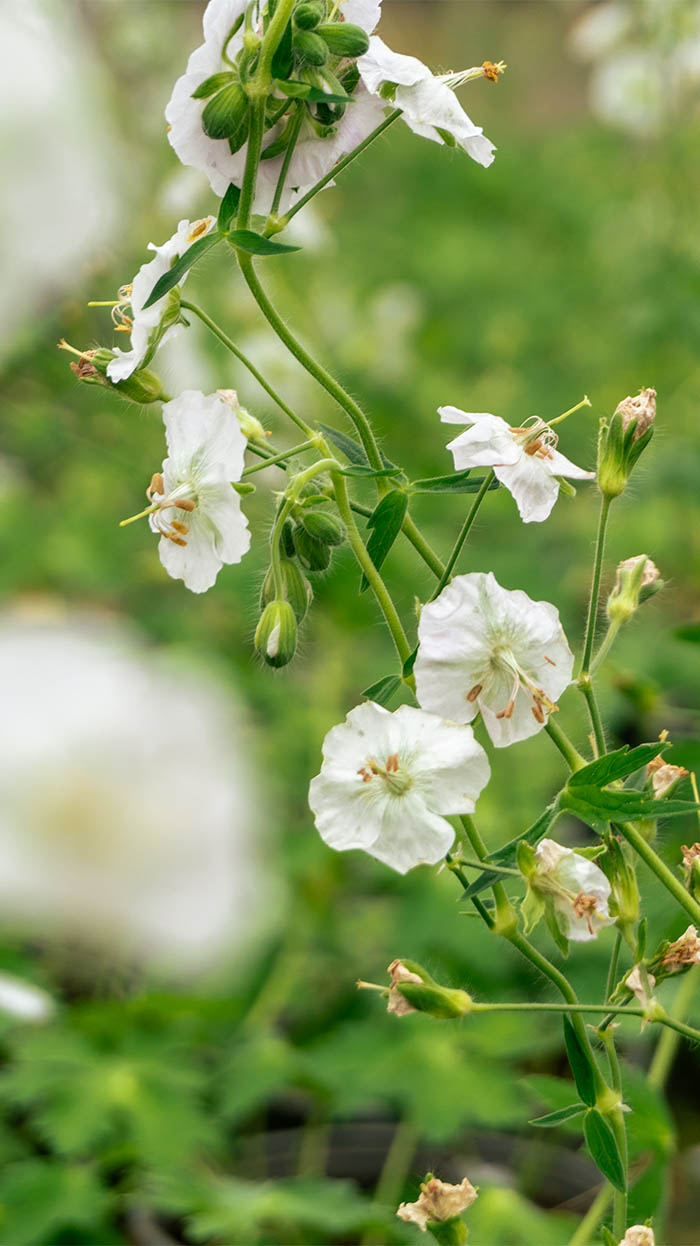
Geranium phaeum ‘Album’
The Geranium genus includes a wide range of species, each with unique characteristics that make them suitable for different landscape applications. Among the best-known species, Geranium macrorrhizum, also known as big root geranium, stands out for its robustness and ground covering capacity. This perennial Geranium is particularly appreciated for its aromatic, deeply lobed leaves which, in autumn, are tinged with red and orange shades. Its bright pink or white flowers bloom in late spring, adding a pop of colour and attracting pollinators.
Another interesting species is Geranium phaeum, known as dusky crane’s-bill, mourning widow or black widow. It produces dark-purple flowers, creating a charming contrast in a planting scheme. Geranium pratense, or meadow cranesbill, offers splendid blue flowers and adapts well to naturalistic meadows and flowering borders. Finally, Geranium sanguineum, also called bloody cranesbill or bloodred geranium, is famous for its bright red flowers and its ability to thrive in difficult conditions, such as poor, dry soil.
Geranium macrorrhizum, however, is particularly loved for its ease of cultivation and ability to form dense, resistant mats, ideal for controlling weeds and stabilising the soil. This makes it an excellent choice for designers looking for reliable, decorative plants for their landscaping projects.
Did you know?
Geranium macrorrhizum, is not only appreciated for its beauty and resistance, but also for its ability to repel mosquitoes. The leaves of this geranium, when rubbed, release a scent intense which, in addition to being pleasant for humansacts as a repellent to insects. This makes it a perfect choice for residential outdoor areas where summer pests can be an issue.
Our favourite Geraniums species:
Geranium endressii ‘Wargrave Pink’
Available in our G Range selection, Geranium endressii ‘Wargrave Pink’ is a long flowering evergreen perennial with veined, divided foliage and saucer-shaped, pink flowers. It loves sun or partial shade, blooms from May to October. It reaches a maximum height of 60 cm, and is also drought tolerant. This plant provides a long season of nectar for bees and other pollinators.
Geranium × johnsonii ‘Johnson’s Blue’
Also included in our G Range, this clump-forming, deciduous perennial features masses of dark-veined, lavender-blue flowers that turn grey as they mature, along with deeply lobed, mid-green leaves. It looks great when allowed to spread at the front of borders, forming a dense carpet of foliage. Loved by butterflies, it thrives in sun to partial shade, and blooms from May to August. Growing up to 30 cm, it is also drought tolerant and attracts pollinators.

Geranium endressii ‘Wargrave Pink’
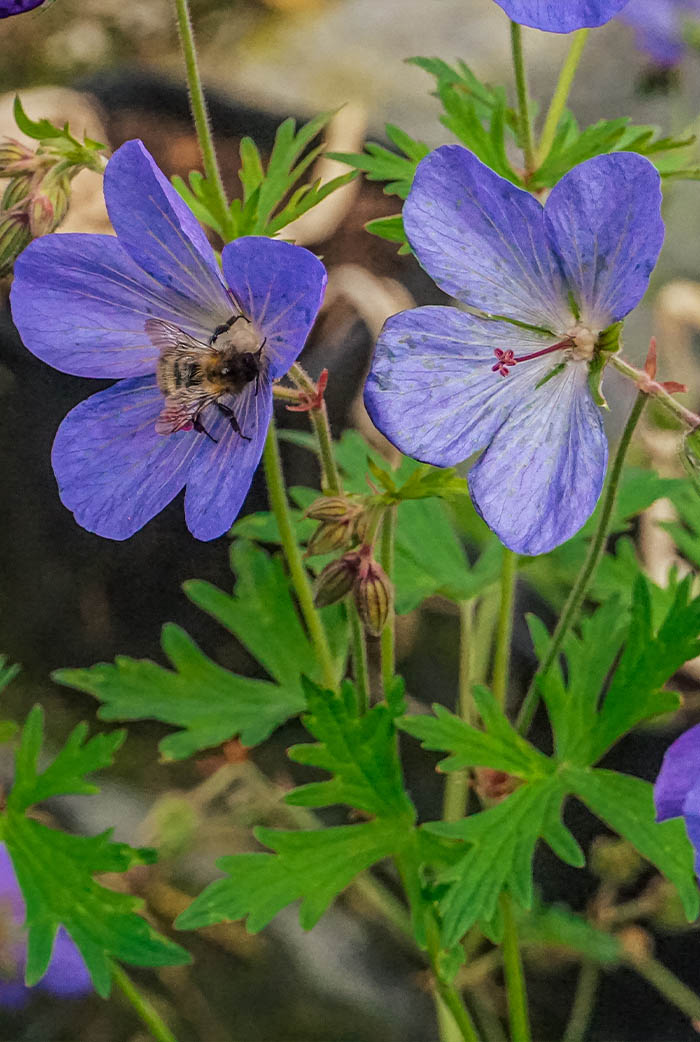
Geranium × johnsonii ‘Johnson’s Blue’
Geranium macrorrhizum
Another G Range option, this mat-forming, semi-evergreen perennial has rounded, lobed, light green leaves that transition to a variety of lovely shades in autumn. Starting in May, it blooms with saucer-shaped, purple-pink flowers on slender, slightly upright stems. Its spreading habit is great for suppressing weeds, making Geranium macrorrhizum ideal for underplanting shrubs. It thrives in sun, partial shade, and shade, grows up to 45 cm, and is drought tolerant. This plant also provides an excellent source of nectar for pollinators.
Geranium macrorrhizum ‘Bevan’s Variety’
Geranium macrorrhizum ‘Bevan’s Variety’ is a semi-evergreen spreading perennial that forms a mat of highly scented leaves. It blooms magenta-pink flowers with brown-red sepals, making it great for groundcover. This versatile plant thrives in sun, shade, and partial shade, blooms from May to July, and grows up to 40 cm in height.
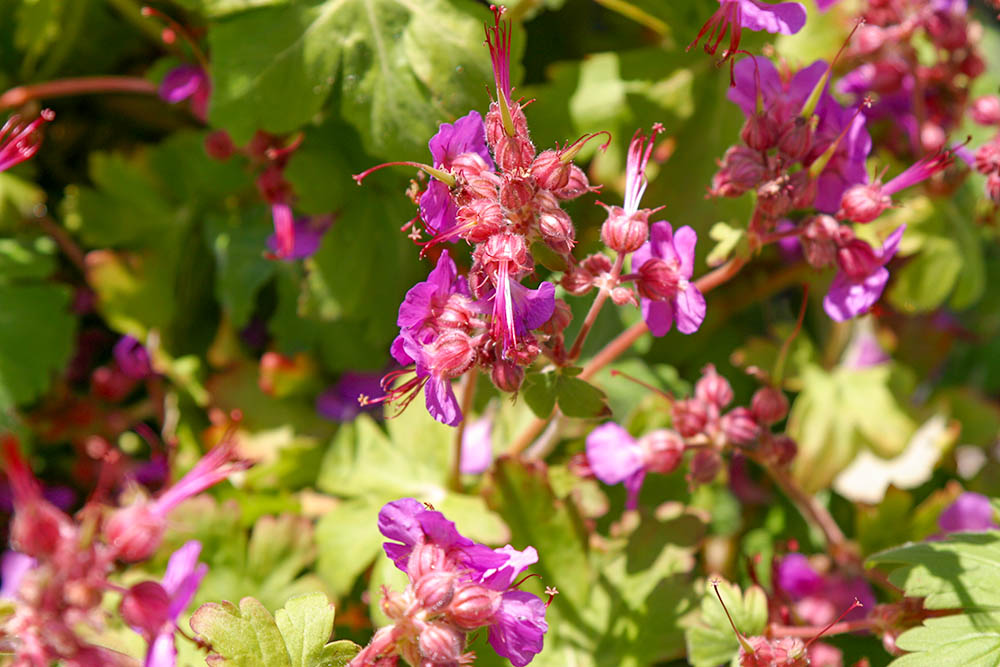
Geranium macrorrhizum
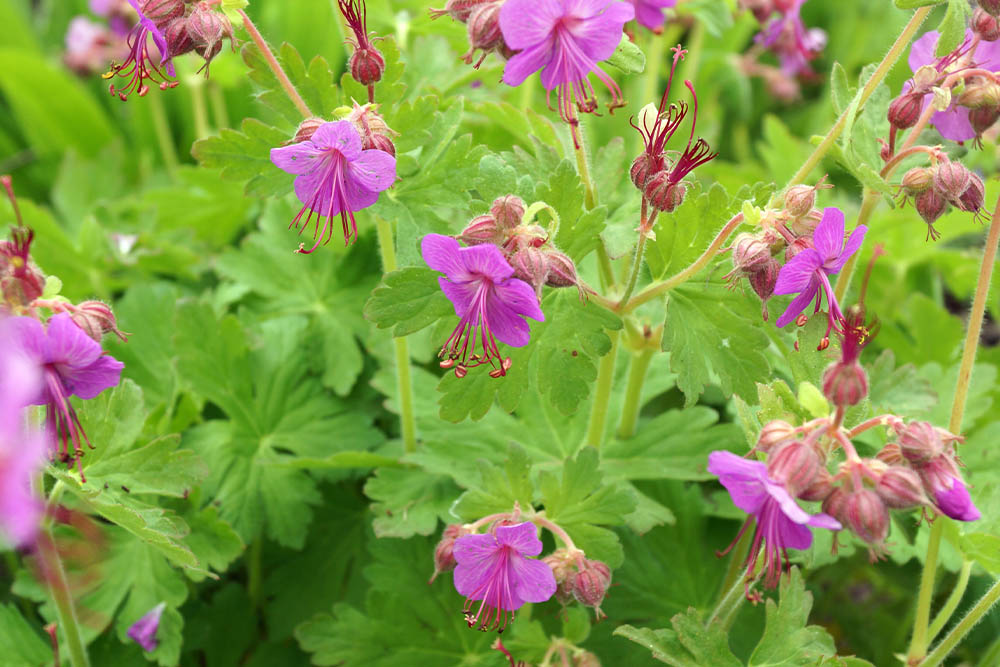
Geranium macrorrhizum ‘Bevan’s Variety’
Geranium macrorrhizum ‘Ingwersen’s Variety’
Geranium macrorrhizum ‘Ingwersen’s Variety’ is a semi-evergreen, mat-forming, herbaceous perennial with aromatic, lobed green foliage and summer flowers that boast soft pink petals and deep pink sepals. This plant thrives in sun, shade, and partial shade, blooms from June to July, and grows up to 40 cm in height.
Geranium macrorrhizum ‘Spessart’
A mat-forming perennial that is well-loved for its aromatic leaves, which turn a stunning bronze-red in autumn. The flowers are soft pink or white with dark red sepals, blooming primarily from June to July. ‘Spessart’ thrives in full sun to full shade and is ideal for use as ground cover, especially under trees and shrubs. It’s drought-tolerant once established, and included in our G Range, making it a low-maintenance and reliable choice for various garden settings.
Geranium phaeum ‘Album’
This mat-forming perennial features deeply lobed, green foliage and pure white flowers with yellow anthers. It thrives in a range of light conditions, from full sun to full shade. It blooms from mid-spring to early summer, with a potential second flowering in early autumn if cut back after the initial bloom. The plant reaches a height of about 60-80 cm and spreads 60-75 cm, forming a dense groundcover that is highly drought-tolerant and low-maintenance. It is ideal for shaded borders and naturalised planting schemes.

Geranium macrorrhizum ‘Ingwersen’s Variety’
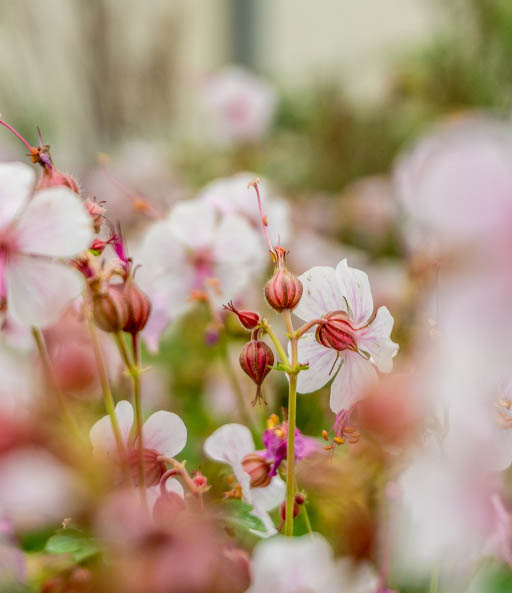
Geranium macrorrhizum ‘Spessart’

Geranium phaeum ‘Album’
Geranium ‘Rozanne’
Geranium ‘Rozanne’ is a vigorous, spreading herbaceous perennial recognised for its long blooming period and distinctive flowers. It features deeply lobed, mid-green foliage with a marbled appearance. The plant produces striking saucer-shaped flowers that are a deep violet-blue with white centres and purple veins. ‘Rozanne’ typically blooms from late spring through to autumn, making it an excellent choice for prolonged garden interest. This plant grows well in full sun to partial shade and prefers well-drained soil. It can reach a height of about 45-50 cm and spread up to 60-90 cm. ‘Rozanne’ is drought tolerant once established, making it a low-maintenance option for planting schemes. It attracts butterflies and other pollinators, enhancing the biodiversity of the local habitat.
Geranium sanguineum
Geranium sanguineum, known as Bloody Cranesbill, is a spreading perennial with shiny, dark green leaves and cup-shaped pink flowers adorned with dark veins and white centres. It blooms during the summer months. Its flowers attract various pollinators, contributing to the local biodiversity. Its adaptability makes it suitable for diverse garden styles, including cottage gardens, where it adds a naturalistic charm. It works well planted beneath shrubs and roses.
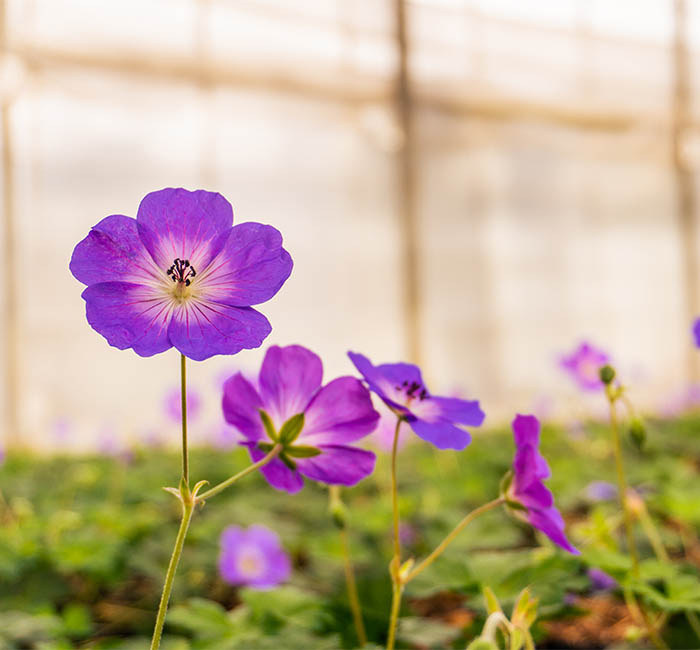
Geranium ‘Rozanne’
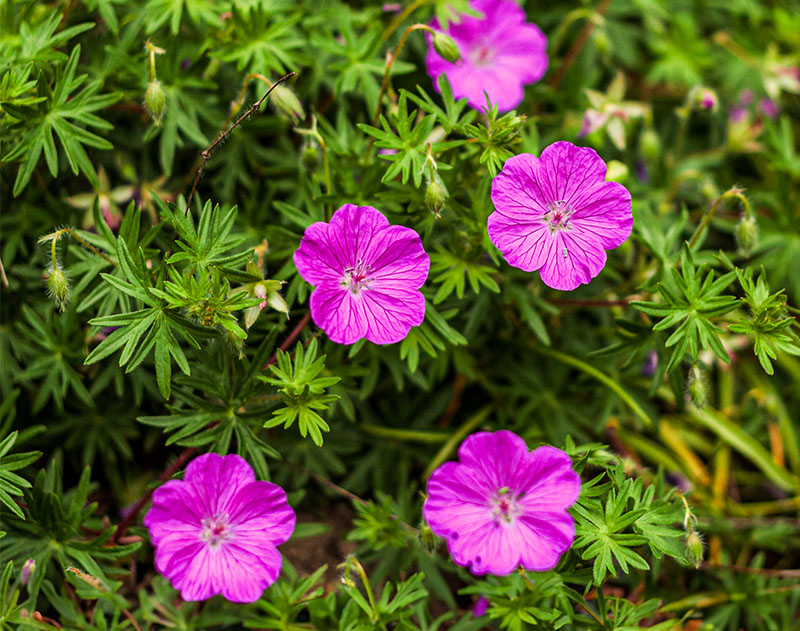
Geranium sanguineum
How to grow and care for Geranium
Geraniums are relatively simple to care for, preferring sunny or partially shaded locations with well-drained soil. When planting, be sure to place plants at an adequate distance from each other to allow good air circulation, thus reducing the risk of fungal diseases. Watering should be regular, but care must be taken to avoid water stagnation. Be sure to let the soil dry between one watering and another to prevent root rot. During the growing season, apply a balanced fertiliser every 4 to 6 weeks to support lush blooms.
Pruning geraniums after flowering helps keep the plant compact and stimulates new growth. Regularly removing faded flowers encourages the continuous production of new buds. To protect plants during the colder months, especially in areas with harsh winters, it is advisable to mulch the base of the plants or move them to a sheltered location. With this simple care, geraniums can thrive and add a pop of colour and vitality to your garden for many years.
Pests & Diseases
Geraniums, despite their robustness, can be subject to various pests and diseases that can compromise their health and beauty. Among the most common fungal diseases are botrytis, which causes grey spots and rot on leaves and flowers, and geranium rust, characterised by orange pustules on the undersides of leaves. To prevent these diseases, ensure there is good air circulation around the plants and avoid overhead watering, which can leave the leaves wet.
Aphids, scale insects and whitefly are the most common pests that affect Geraniums. Aphids feed on plant sap, causing deformations and reducing the vitality of the plants. Scale insects form cottony colonies that weaken the plant, while whiteflies can cause yellowing and transmit viruses. To control these pests, you can use natural insecticides such as neem oil, or introduce natural predators, such as ladybugs. Be sure to regularly inspect the plants to identify any infestations early and keep the geraniums healthy and thriving.
Fun fact:
Geraniums became popular during the Victorian era, being planted frequently at grand country estates. Their gardens would be embellished and enriched with every known variety of geranium.
Within a few years, however, their popularity began to wane, so much so that by the nineteenth century, the Geranium was known as the flower of the street.
To learn more about the Geranium species that we grow and sell, speak to the G Team today.

